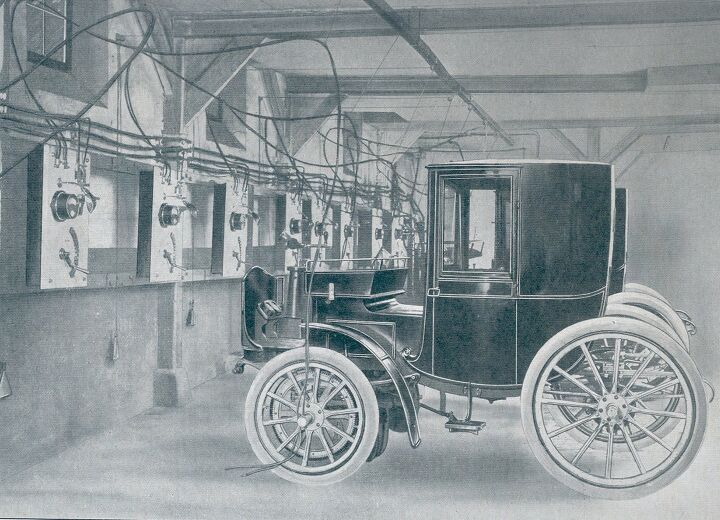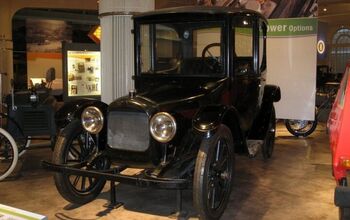Plus a Charge: Electric Touring

Note the date of publication is 1914, not 2013
While following the he said he said back and forth between the New York Time’s James Broder and Tesla’s Elon Musk, over Broder’s unsuccessful drive from New York to Boston in a Tesla Model S, it seemed to me that one important factor affecting consumer acceptance of EVs is being obscured by all the Sturm und Drang of the NYT and Musk both working this story for maximum bad publicity for their respectless enterprises. That factor, ironically, is why Tesla set up the media road trips in the first place, the fact that EVs will need a publicly accessible charging infrastructure if they are going to be seen as anything other than town cars. The Model S press trips from DC to Beantown were supposed to demonstrate Tesla’s expanding network of locations equipped with Tesla’s “Supercharger” quick charging stations.
That need for public charging stations has been obscured by other issues in the discussion of electric cars, which it seems to me have been focused more on range than anything else. Tesla is not unwise to create it’s own charging infrastructure for its customers because the simple fact is that if you could recharge an EV as quickly and as conveniently as you can refuel a gasoline or diesel powered vehicle, and if you could find a charging station within your EV’s range, range becomes more of a non issue. Let’s face it, how many owners of gasoline cars really consider range on a single tank of gas when buying a new car? As long as you can get ~300 miles between fill ups, the vast majority of car consumers don’t really care about range. Gas mileage yes, but I’d bet that total range is only important to a minority of gas/diesel drivers.
This is nothing new. Like 3D photography and movies, this is not the first go-round with EVs. Electric cars and were marketed more than a century ago, at the dawn of the automotive age and soon enough electric car companies, electric component makers, trade organizations, tire and battery companies, and publishers rushed in to help EV owners find a charge.
The EV side of the auto industry understood that drivers of EVs would need public charging facilities at the same time that it promoted electric cars as suitable for touring. The Electric Vehicle Association of America even published a charging station guide to the Lincoln Highway, America’s first attempt at a coast to coast road. Since the longest distance between charging stations was about 120 miles, well beyond the range of any contemporary electric car, it’s doubtful than any early electric automobilists completed the entire route, but the EV industry did what it could to dispel the image that electric cars could not be taken on long trips. Tesla is doing the same today.
The fact that the Electric Vehicle Association agreed on a standard charging plug that was used by most EV makers made things a little easier. In the photo above, the charging port on a 1922 Milburn Light Electric is being held open so you can see the terminals in the photo above. The photo below shows a similar charging port, though closed, on a 1914 Detroit Electric runabout.
By 1912, the Detroit Electric Car company, the most successful of the first wave of EV makers (it has only been in the past year that the Nissan Leaf surpassed the Detroit Electric as the most successful EV ever, in terms of total sales) had both standalone charging garages as well as combined sales branches and charging stations in Detroit, Manhattan, Chicago , Boston, Brooklyn, Buffalo, Cleveland, Evanston, Kansas City, and Minneapolis.
In 1914, the New York Electric Vehicle Association, in conjunction with Automobile Blue Books started publishing route guides for “electric touring”, that mapped the locations of charging stations and provided suggested touring routes.
The guide was updated, apparently annually. In an emergency, drivers of electric cars could get a charge from electric streetcar or trolley wiring – as this Tom Swift story relates.
While General Electric sold mercury arc rectifier based residential chargers to EV owners, the majority of the more than 14,000 chargers that GE sold a century ago were sold to public facilities like hotels and parking garages.
The Exide battery company, perhaps the major EV battery maker in the early days of the automobile, set up its own storage and charging garage (many city dwellers didn’t have residential parking for their cars) and “battery depot” in New York City.
In addition to public charging facilities, taxicab companies that operated electric cabs set up their own charging garages and had chargers installed for their drivers’ use at hotels they serviced.
As was shown 100 years ago, broadscale consumer acceptance of electric cars needs a publicly accessible charging infrastructure. It’s unfortunate that the war of words between Mr. Musk and the New York Times is obscuring rather than illustrating that need.
Ronnie Schreiber edits Cars In Depth, a realistic perspective on cars & car culture and the original 3D car site. If you found this post worthwhile, you can dig deeper at Cars In Depth. If the 3D thing freaks you out, don’t worry, all the photo and video players in use at the site have mono options. Thanks for reading – RJS

Ronnie Schreiber edits Cars In Depth, the original 3D car site.
More by Ronnie Schreiber
Latest Car Reviews
Read moreLatest Product Reviews
Read moreRecent Comments
- Slavuta Nissan + profitability = cheap crap
- ToolGuy Why would they change the grille?
- Oberkanone Nissan proved it can skillfully put new frosting on an old cake with Frontier and Z. Yet, Nissan dealers are so broken they are not good at selling the Frontier. Z production is so minimal I've yet to see one. Could Nissan boost sales? Sure. I've heard Nissan plans to regain share at the low end of the market. Kicks, Versa and lower priced trims of their mainstream SUV's. I just don't see dealerships being motivated to support this effort. Nissan is just about as exciting and compelling as a CVT.
- ToolGuy Anyone who knows, is this the (preliminary) work of the Ford Skunk Works?
- Kwik_Shift_Pro4X I will drive my Frontier into the ground, but for a daily, I'd go with a perfectly fine Versa SR or Mazda3.


















































Comments
Join the conversation
Most people don't appreciate the amount of energy they carry around in the 18 gallon gas tank of their car. If you look up "energy density" in Wikipedia, you can see that gasoline has an energy density of ~46 MJ/Kg. (mega-joules per kilogram) while a lithium ion battery (of the type used by Tesla, has an energy density of 0.72 MJ/Kg. Also, the rate at which you can transfer energy in a three minute fill up at the pump is staggering, if you were convert the energy transfer in to electric power terms. I won't bother with the math, but at 240V, it would be a massive amount of current.
Speaking of electric touring, apparently seven Tesla owners took to the road this weekend to retrace the Broder trip: http://www.mercurynews.com/cars/ci_22610702/teslaroadtrip-participants-tout-their-model-s-sedans-and